Camp Perry 2002
By Dick Culver
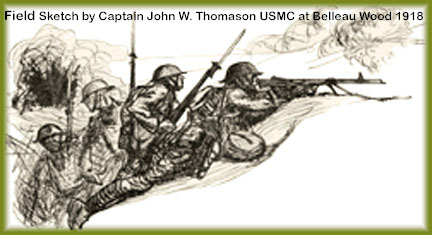
Camp Perry 2002 By Dick Culver  |
| T he
early morning light was just making its appearance over the eastern end
of Viale Range and the stalwart shooters for the National Trophy Infantry
Trophy Match were gathering, with team captains and coaches holding a preliminary
muster. The Garand Collector's Association "Gold" NTIT Team was obviously ready and raring to go. The bright red sun was lighting up the range flags, and coaches up and down the line were busily taking notes. A substantial wind was whipping across the range, somewhere between 15 to 25 mph, and even more intimidating was the fact that it varied from a full value to half value on a regular basis.Such a wind is not unreasonable, but the coach must be constantly alert to subtle changes during a string of fire. This is not a job for the uninitiated unless he (or she) is carrying a silver horseshoe. |
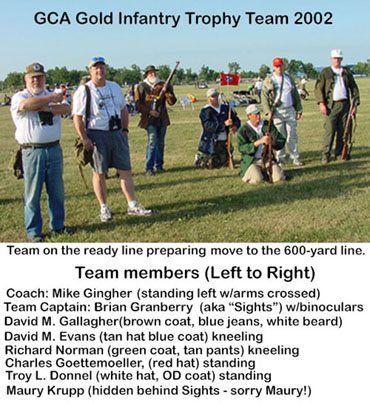 |
| While I had planned to have a much greater input into the proceedings, I was sidetracked in a Civilian Marksmanship Program meeting preparing for next year's celebration of the 100th anniversary of the formation of the DCM/CMP. While the meeting was supposed to be over by 1900 (7 PM for you civilians), by the time I arrived back at Camp Perry, it was 2200 (10 PM) and Mike Gingher was fit to be tied. He was extremely interested as to where I had been and eyed me suspiciously when I gave him the explanation! Hmmm… He gave me the target assignment (139 - 143) and informed me that we were on the 2nd relay. Making a mental note not to be late again, I set my mental alarm clock and hit the rack. Now 0300 comes early, but I grabbed my camera (determined to take some decent pictures of our endeavors) and headed down to the line at about 0530 (the coffee shop opened at 0500!). |
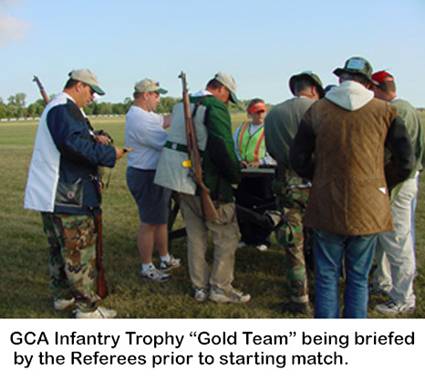 |
Not knowing if I had somehow vanished into the woodwork, Mike had made alternate plans in the event I didn't show up. As it turned out, he did extremely well. I was an old time Rattle Battle shooter, and had coached the number 2 Civilian Team in 1965 (Virginia State), but hadn't had a lot of exposure in the ensuing years. Mike conversely had assisted the Marine Corps Reserve Team more recently. Brian Granberry, (better known as "Sights" on the CSP Forum) volunteered to be the second coach. The NTIT Match is set up in the manner of a pre-WII Army Rifle Squad and is composed of 8 individuals. Six of the members are shooters, and the other two act as the squad leader and assistant squad leader.Each of these individuals act as coaches for three of the six shooters,calling wind and directing additional shots on wing targets, to those known as "swing shooters" to ensure that the team gets the maximum number of bonus |
| points allowed. Officially,
the two coaches are carried on the official sheet as the Team Captain and
the Coach, with Mike acting as the Coach and "Sights" as the official Team
Captain. Most teams shooting in the Infantry Trophy Match have practiced together for months, or at least weeks prior to their debut on Match Day. Because we drew our team from volunteers from the CSP Page and the GCA Website, and of course, all shooters were required to be members of the Garand Collector's Association, our team members were essentially strangers with NRA Classifications running the gamut of experience from old timer to novice. As it turned out, the hastily organized team turned out to be very effective indeed, considering the relative lack of experience of our volunteer shooters in firing the NTIT. Until everyone arrived at Camp Perry, we had no guaranteed way of ascertaining who would be available to shoot - needless to say, this is a "thrilling" method of team selection. Unlike regularly organized teams including the service teams, and those drawn from an individual club, this outfit would have been described as a "scratch team" in sandlot baseball. The only thing(s) these guys had in common, was membership in the Garand Collector's Association, a love of shooting, and a perverse dedication to the preservation of the M1 Rifle. Gary Anderson, Orest Michaels, and the entire crew at the CMP should be proud of this crew firing a rifle that was an old timer when "I" was a kid, and I don't intend to disclose how far back THAT goes! |
| The total number of rounds designated for the Infantry Trophy Match is 384, paralleling the number of rounds in a pre-WWII case of ball ammunition. Sights, in a rare moment of brilliance, had personally handloaded enough ammunition with boat-tailed projectiles for all of the long-range stages (allowed under the current rules), and left us shooting M2 (150-grain flat-based projectiles) at the shorter ranges where gilt-edged accuracy is not as critical. M2 Ball will do very well at the 200 and 300-yard line, but the boat-tailed projectiles give you a definite edge at 500 and 600-yards. Ammunition is issued at the 600-yard line prior to the shooters getting into position. The ammunition can be redistributed between stages according to the | 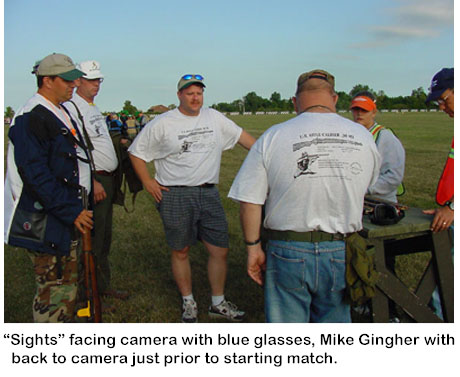 |
| judgment of the coaches.
The heaviest hitting shooters are normally designated as "swing shooters" and are given the job of allocating their rounds between two targets to ensure garnering the bonus points available at each stage of fire. For those of you not familiar with the rules of the Infantry Trophy Course, every target with at least 6 hits counts as a bonus target. Each team has 8 targets and only 6 shooters. At the end of each string of fire, the number of targets with 6 or more hits is "squared" and the resultant number is added to the hits scored (for example if you have all 8 targets with 6 hits, your score is increased by squaring "8" for an additional 64 points! Needless to say, hit distribution is high on a coach's list of "musts" for a maximum score. The bonus scheme is designed to ensure "fire distribution" (don't forget, this is, or at least was designed to be a simulated "combat match" and no alibis are allowed for any rifle malfunction). The progress of the team is evaluated at each yard line and the ammunition is (or can be) redistributed as the coaches see fit. Of course, as GCA representatives, our team was shooting M1 Garand rifles. Needless to say, shooting the M1 in the NTIT Match is a bit more challenging than shooting the "Mouse-Gun," as the lack of recoil in the M16/AR-15 makes recovery between shots easier and fire-distribution a piece of cake, relatively speaking. What ISN'T said is that a good shooting .30-caliber team is (or would be) a much more effective combat unit than one who shoots 'em through the same hole with a varmint rifle. Score isn't everything, and shooting a decent score with a REAL rifle is a much more satisfying experience than doing the same thing with a "gallery-practice" rifle. Rest assured that our GCA Gold Team performed extremely well - I was proud of them, and I have seen some of the best! As an aside, prior to WWII, the Infantry Trophy Match required that each team (both military and civilian) were required to have a fully functioning Browning Automatic Rifle issued to one member of the team. That must have made for a truly thrilling match! |
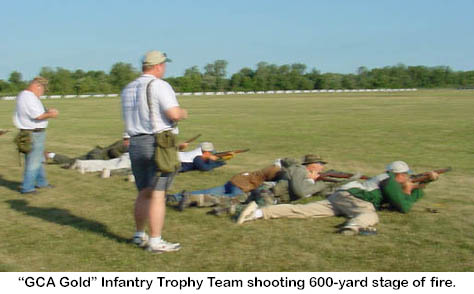 |
Mike Gingher and I compared notes on the wind, and essentially agreed on the velocity and sight changes. What made it a bit challenging was the fact that some of our shooters were using ˝ minute sights and some were using full minute sights. A sort of code had to be worked out to get the word out to the shooters during the actual shooting. Yelling "one click right" (for instance) could mean two different things to two different |
| shooters depending on the rifle being used by the shooter. While we may have had some relatively inexperienced shooters (in the Rattle Battle), what they lacked in experience, they more than made up for in enthusiasm. Mike's code worked and as best I could tell, no one misinterpreted his signals during the slight changes in the wind. |
| Not only was I proud of the shooters (none of whom had ever fired the NTIT Match before), and Mike and Sights did a superlative job coaching the team. Early on, it was apparent that Mike had his "stuff" wired on the wind, so I concentrated on getting us some good pictures to show the guys who stayed at home. The only way I could accompany the team downrange (and thus take pictures) was to act as a "brass-rat" and help pickup the clips and brass as we went from yard line to yard line. Our brass was | 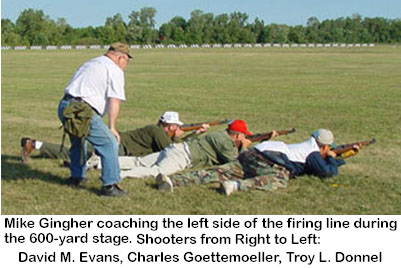 |
| uniformly distributed in the 1 o'clock to 2 o'clock position (in front of each rifle) indicating that the rifles were properly cleaned and lubed. Again, these guys were performing as experienced service rifle shooters from an era of long ago - AND they were shooting a real rifle! The grins on their faces as we went from position to position told the whole story - not only were these guys performing well, they were having FUN! I was totally charmed! |
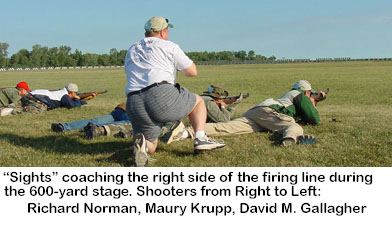 |
As we jumped off from the 600-yard line, a young Marine Reserve NCO was sorta' following along with us. We were talking as we made our way downrange, and he suddenly realized that we were all using M1 Rifles! He expressed his amazement, but I pointed out that these guys were the Garand Collector's Association Team and he even went down and pulled targets with us in the butts. I think he fell in love with the rifle I grew up with! |
| He couldn't get over the hits we were getting with antiques! I suspect that the CMP will shortly be getting a request for an M1 Rifle. As the final cease fire was given at 200-yards, it was obvious that we had very few rounds left at the short range (always a good sign, as hits only count as 1 point each at 200-yards), and most teams try to expend their rounds prior arriving at the short range stage. We only had about 1 -round per shooter left, quite phenomenal actually, and our hit count had been respectable from each yard line, especially considering the experience of our shooters! Heading for the butts, I noticed a junior team just in front of us going down for a similar experience in teamwork. They looked so great that I was cursing myself trying to get a new | 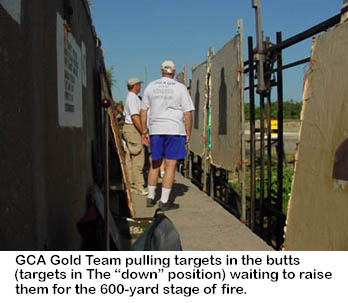 |
| disk into the camera.
They were diminutive in stature, but were all wearing matching shooting
coats and carrying their AR 15A2s over their shoulder. They gave the appearance
of a mother hen (the team captain) leading her chicks in a line in the barnyard.
The emphasis on the junior program was obviously paying off. My faith in
the future of the National Trophy Matches was considerably enhanced. We mustered at the 200-yard line and prepared to go to the butts to pull targets for the next two relays. Mere photographer or not, I was not to be denied pulling targets, it's one of those things that comes with the territory, and always cements camaraderie between shooters in high-power rifle shooting. This day was no exception. A final muster of our shooters revealed a universal display of brilliantly displayed dental work and a resolve to come back next year as "experienced" Rattle Battle Shooters. You can shoot all the high-power rifle competition you want, but until you have shot the Infantry Trophy Match with a real rifle, you simply don't understand the purpose of the National Trophy Matches! Did we win the match? Nope, but conversely, our performance with a .30 caliber service rifle would have done us proud in an exchange with the barbarians at the gate. With shooters such as these, our future as a country is assured. A tip of the hat to Mike Gingher, Brian Granberry, and the members of the GCA Gold team! Well done lads! ROC |